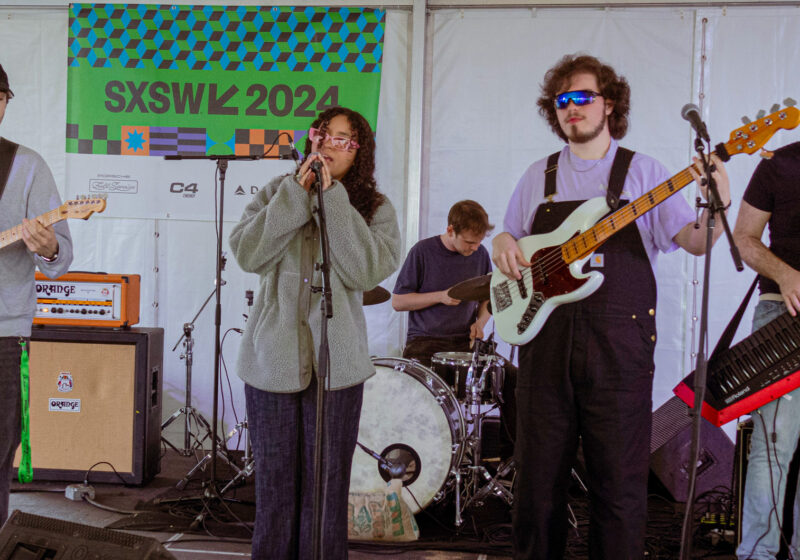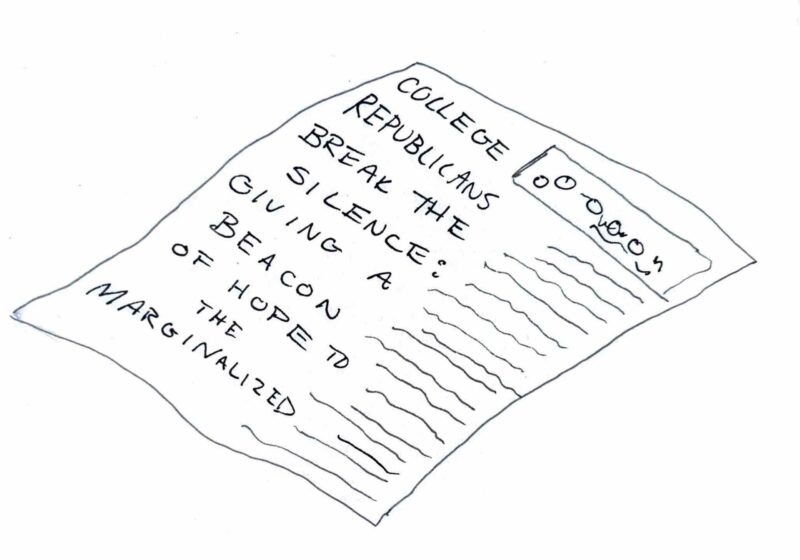Two weeks ago, I stepped through the doors of a crowded music venue, got large black Sharpie “X”s drawn on my hands, and shuffled past the narrow bar-side passage into the stage area, where blue and purple lights illuminated a simple setup — a drum kit flanked by three healthily-sized amps and a keyboard, one of which was topped with a characteristic potted houseplant.
The venue, New York City’s tiny Mercury Lounge, has been home to all bands independent, unique, and up-and-coming since its inception in 1993. It’s seen performances from some extremely notable artists across genres, too — garage rock revival icons such as the Strokes and the Yeah Yeah Yeahs got their start there, while international pop superstars like Katy Perry and Lady Gaga lit up its stage at the beginning of their careers.
After the opening act left the stage, a group of casually dressed college students, many wearing sunglasses, walked on and set up their instruments — a keyboard, drum kit, tenor saxophone, Fender Telecaster, and a five-string Jazz Bass. First, the keyboardist laid down a series of rich, syrupy chords, followed by floaty melodic lines from the saxophonist and a pulsing beat from the drums. Guitar entered next, strumming with fluttering and percussive palm-muted euphoria. Then the bass — its round and muffled tone glided across the low end, dancing around the chords with masterful dexterity. Finally, the vocalist joined in, her smooth and quiet voice singing the catchy melody of a verse. These delicious harmonies, mercilessly in-the-pocket rhythms, and soaring melodic licks were delivered straight from the souls of Telula, an upstate New York-based jazz-funk number who tour around the Northeast regularly — and who are playing right here in Rochester this coming Thursday.
Telula is, by all accounts, a two-man show — bassist Lucas Aney and guitarist Thomas Jensen write and arrange every vocal and instrumental part, produce the band’s studio tracks, and run their social media pages. Meeting each other during their first few days at SUNY Purchase College’s music conservatory in Westchester, they described their origins to me over a Zoom call one Saturday afternoon.
“[The first time we met], Lucas told me he had this really cool vintage Jazz Bass, so he invited me over to his place to play it …” Jensen told me.
The duo, who lived on the same dorm floor, soon discovered a shared love for funk music.
“We were sitting in my dorm with our guitars,” Jensen said, “and we somehow both figured out we [knew] how to play ‘Ace of Aces’ [by the Fearless Flyers], and we pulled up the track and played it and we were like, ‘Holy shit. We gotta make some stuff together,’ because it sounded great when we played.” And for good reason — Aney, raised in New York City’s Hastings-on-Hudson suburb, and Jensen, brought up in the small city of Hastings in Minnesota, both began playing music at very young ages.
Aney said he first played cello in third grade before switching to bass in fourth grade band, despite ranking it last among his instrument choices. Then, in eighth grade, he began taking lessons and “taking it seriously with electric [bass]” as his main instrument. Jensen got a similarly early start, moving through a series of instrumental phases before settling on studying guitar.
Deciding to pursue jazz at the collegiate level, the two settled on attending SUNY Purchase’s music conservatory as part of the jazz program. “When you’re trying to find a balance of price, size of a program, attention to every student, quality of the faculty and their dedication to the program, location … [Purchase] is a very good mixture,” Jensen said. “Being at a place [where you’re] surrounded by so many different types of artists is a huge benefit creatively … A lot of artists come out of our school, whether that’s directly from learning from the program or just the fact that it’s a great breeding ground for art because it’s a small school. It’s just a very creative place to be.”
Aney agreed, highlighting the size of the program: “The jazz program is very small,” he said. “There’s usually [around] 100 to 120 people in the whole program.” This small size, Jensen added, allows students to form intimate relationships with their professors: “[In] some of these larger music schools,” he added, “you’ll maybe only be able to work with one professor for one semester, or maybe never get to work with the professor you want to work with, whereas I get to study with my guitar professor [for] an hour a week for four years straight.”
Like many guitar and bass beginners, Aney and Jensen were first influenced by rock and metal bands like Guns N’ Roses, Black Sabbath, and Iron Maiden. Once they began playing on an academic level, they found themselves drawn to jazz, which led them back to the modern jazz-funk genre. Vulfpeck, who Jensen and Aney cite as one of their primary influences when starting Telula, is a funk band from the University of Michigan’s music conservatory who began releasing music back in 2011 and is now considered some of the pioneers of the modern “low-volume” funk genre. In other words, you can’t talk about Telula’s brand of funk music without talking about Vulfpeck.
When asked to name the musicians that had the most influence on their sounds, Jensen chose Nile Rogers, a guitarist for 70s disco band Chic that pioneered the palm-muted funk guitar strum; Cory Wong, Vulfpeck’s extra-speedy rhythm player; and James Hetfield, the rhythm guitarist for Metallica — “it’s just in my DNA at this point,” he said. Aney, on the other hand, also cited Chic and Vulfpeck as inspirations (Chic’s Bernard Edwards and Vulfpeck’s Joe Dart, respectively), as well as world-famous electric jazz bass virtuoso Jaco Pastorius, who became popular in the ‘70s and ‘80s for his complex, melodic, and funky playing on his custom fretless Fender Jazz Bass. “[When] I eventually got introduced to Jaco, I was just enamored by what he was doing on the bass …” Aney told me.
Although Telula’s sound is directly influenced by these jazz, funk, and even rock icons, their sound is constantly evolving. Initially, the band’s sonic aesthetic was inspired by indie/electropop acts like Tame Impala and Men I Trust, paired with funk artists like Vulfpeck, Stevie Wonder, Parcels, Hiatus Kaiyote, Thundercat, and Jamiroquai. On their new album, though, they plan to delve into the sphere of modern R&B with artists like Anderson .Paak, and D’Angelo, as well as drawing from jazz fusion masters such as CASSIOPEIA and Masayoshi Takanaka. “[Our] tastes have changed over the course of the time we’ve been in college,” Jensen told me, “[so we’re] just trying a bunch of different stuff, trying to make fun music that we like and music that people can dance to … We want it to groove. That’s the main thing.” And groove it does — Telula’s first album, first EP, and a series of singles from their new project, have garnered them over 62,000 monthly listeners on Spotify. Clearly, there’s an audience for their music.
So how do they go about crafting their songs? “We just mix it up,” Jensen said when asked about their songwriting process. “We both sit down and decide the vibe [or] style of song we want to create. Then sometimes we’ll create that on our own and create a demo, or sometimes we’ll create it together in the same room. As far as the instrumental parts go, we both write all the parts musically …” Some positions, however, are generally fixed: “I’m always the one doing the production, and until this most recent album, I was the one that did all the lyrics,” Jensen said. Both Jensen and Aney agree that the song they’re most proud of writing is the smooth and catchy “Let Me In,” which is their most popular song on Spotify. “I think there’s a pretty big Chic influence in that one,” Jensen described. “[There’s] a little bit of Men I Trust influence too on the verses with all the chords and the soft vocals. I’m overall really proud of that song.”
As jazz students, their approach to songwriting is also influenced in large part by that genre. When Aney writes, he tends to base his harmony in seventh chords and utilizes common jazz chord progressions like the 2-5-1. Jensen also draws inspiration from jazz, specifically pulling from his skills of improvisation. “If I sit down to write something, it almost always comes from improv,” he said. “I may use theory to compose the rest of the song or make sure everything ‘works,’ but it’s usually based on my ear.”
Their unique visual aesthetic is handled by a very special member of their creative team. “There’s been a man that has been alongside us through the entire thing. “His name is ‘Wild Will,’” Jensen said, stressing the name as he said it. “He’s a photographer, and he’s filmed almost every video we’ve ever done, he’s made every single album cover, he makes all our posters — everything visual you see has been created by Wild Will.”
The inspiration for their name, however, was Jensen and Aney’s idea: “There’s a Jamiroquai song called ‘Tallulah,’ and we were like, ‘How about we just spell it different?’ We wanted something that just sounded nice and was easy to spell,” Aney said. The design of their online posts and on-stage setup also follows a unique aesthetic — because of the similarity between “tulip” and “Telula,” Jensen started adding tulip emojis to the descriptions of their social media posts, prompting the adoption of a floral theme. “I guess I did it to be a little more eye-catching on the text part of our videos. I had some fake plants in the room and we started including those in the videos, and now we bring plants on stage,” he said.
As far as gigging goes, their experiences have only been positive. “We’ve played probably like 25 or 30 shows, which is solid,” Jensen said. The shows haven’t always proven to be the most profitable, however: “For now, [we play shows] basically for exposure but mainly for fun,” Jensen added. “And for the close fans that we do have, being able to get out and play for them is what this is all about. Aney added onto this, saying, “A big part of that is we have a large band, so going to hotels and [buying] gas [is expensive].” The undisputed highlight of their gigging experiences was their spontaneous trip across Europe after playing a private party in Germany. A delayed flight ended up landing them a few days in Iceland, which they took advantage of. Jensen described the trip, smiling at the memory. “It was fucking awesome. We just drove around Iceland in a Volkswagen listening to Animals as Leaders. We spent a bunch of time in Amsterdam, a bunch of time in Germany — it was just an awesome trip.”
And that brings us to today — Telula is playing at the Bug Jar here in downtown Rochester this coming Thursday, Nov. 7. Connor, their Rochester-native saxophone player, was responsible for convincing them to make the trip.
It may not be Iceland, but Telula is excited to be bringing the groove to Rochester. Jensen’s message for UR students is simple: “Pull up. It’s gonna be dope. We like to throw a party. It’s interesting instrumentation and parts if you’re a musician, and if you’re not a musician, it’s just danceable music. We like to have fun.”
Telula truly does have something for everyone — whether you’re a music prodigy or you listen to Spotify for an hour a year, Telula is bound to wow you with their energy, stage presence, and the raw funkiness of their performances. So be there — add a little groove to your Thursday night with a fun, affordable, and intimate performance from some of today’s up-and-coming funk masters.



